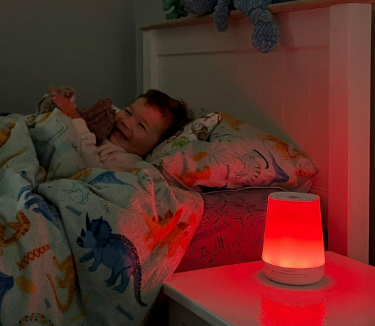Creating a Sleep Environment to Encourage Better Sleep
- Babee Dreams
- Dec 15, 2022
- 4 min read
Updated: Jun 26
Their sleep environment plays a crucial role in determining the quality and duration of sleep, and making specific adjustments to the bedroom can effectively encourage better rest. Whether you have the bedroom already set up or you're an expectant parent preparing their room, here are my best tips:
Adjusting the bedroom to promote and encourage better sleep
Dark room
When we say dark, we mean so dark you cannot see your hand in front of your face. The best way to determine this is by standing in their bedroom for a few minutes until your eyes adjust and ensure you can't see anything. The reason for this is to produce melatonin.
What is melatonin? Also known as the sleep hormone. It is a natural hormone that is released in the brain when darkness occurs, causing a sudden increase in tiredness.
From birth: Your baby doesn’t produce their own Melatonin when they’re born. The only way your baby can get their melatonin so early is through breast milk. If you aren't breastfeeding, still keep the room dark as this will remind your baby of the womb.
From 3-4 months: Your baby will start to develop their own production of melatonin.
Click for fun fact
Babies are not afraid of the dark. Usually, the fear of the dark happens around 24 months old, when they’re old enough to imagine, but not old enough to distinguish fantasy from reality.
Sound machine
Studies show that 80% of babies fall asleep faster and stay asleep longer with a white noise machine present in their sleep environment, and here's why:
Signals it’s time to sleep: When they hear the machine on, they know it’s time to sleep and vice versa.
Mimics the womb: For 9 months, all they heard was whooshing, so when you play white noise for the entire duration of sleep, it makes their bedroom a place of security and calmness.
Blocks external sounds: Sounds coming from outside the bedroom can disrupt sleep, such as loud cars, loud conversations, TV playing, older children being loud, garbage trucks and birds chirping in the early morning.
Click for tip
Use a smartphone to download a decibel reader and place the device where your baby will be sleeping, aim for the volume to be around 60-70 dbl. Which isn't loud enough to hurt your ears, but loud enough to mask external sounds.
Temperature
Assess the room temperature based on your comfort level, as it will likely be the same for your baby. Aim for a perfect room temperature of 18-20 degrees Celsius to create an ideal sleep environment.
Click for tips
Tip 1: The easiest way to tell if your baby is too hot or cold is by feeling the back of their neck to see if it is sweaty or cold to the touch.
Tip 2: To ensure they aren’t getting too hot or cold is to set the heater at a comfortable temperature and make sure they wear a sleeping bag every single night, with the appropriate layering of clothing underneath.
No distractions
When setting up a baby's bedroom, it is important to avoid hanging mobiles, excessive toys, pillows, bumpers, and blankets. Studies have shown that these items can increase the risk of Sudden Infant Death Syndrome (SIDS) and can be distracting for your baby. The cot should only contain your baby, a sleeping bag (or a swaddle), dummies and a comforter if they use one — nothing else should be in the cot.
An empty cot is a safe cot: Studies examining children’s attachments to various classes of objects found that strong attachment to blankets is rare around 3 months (8%), peaks at 18 and 24 months (32%), stays near this high level through 39 months, and diminishes steadily to 8% through 63 months.
Babies under six months of age do not engage in exploring objects in their sleeping environment and are developmentally too young to take comfort from a toy or object to help them manage any separation from their mother Here's a safe sleep checklist I have created for your reference.
"Will my baby get used to sleeping this way?"
or “what if I’m not home, they won’t be able to sleep elsewhere?”
Parents often express concerns about their baby's ability to sleep in different environments when they are not at home. However, it's worth considering the benefits of providing your baby with the best possible sleep experience.
Babies are highly adaptable, and if they are already good sleepers, they can often sleep well in alternative environments. While being out and about, you may not be able to replicate all the sleep conditions mentioned earlier, so it's okay to adjust your expectations slightly. Nonetheless, it's important to note that sunlight can suppress melatonin production, even if you have a good sleeper, they can still find it difficult. Please avoid covering prams with a sheet or a cover as the heat underneath rises rapidly and this can become very dangerous
Do you need help?
Is your baby's sleep environment set up like this and they're still struggling with sleep? I have the perfect tools and resources to help you! I have guides and optional plans that can give you that one-on-one support you need to help achieve 10-12 hour nights, solid naps and put an end to all or most sleep struggles.

I'm the founder of Babee Dreams, a certified sleep consultant, and a mum of three. Everything I share is from evidence-based research, professional training through The Sleep Consulting Academy, real-life success stories from families I've worked with, and the instincts that come from being a mum.
Disclaimer: This blog is for informational purposes only and is not a substitute for professional medical advice. Always consult your healthcare provider for personalised guidance regarding your baby's health and well-being, Babee Dreams does not give medical advice.



